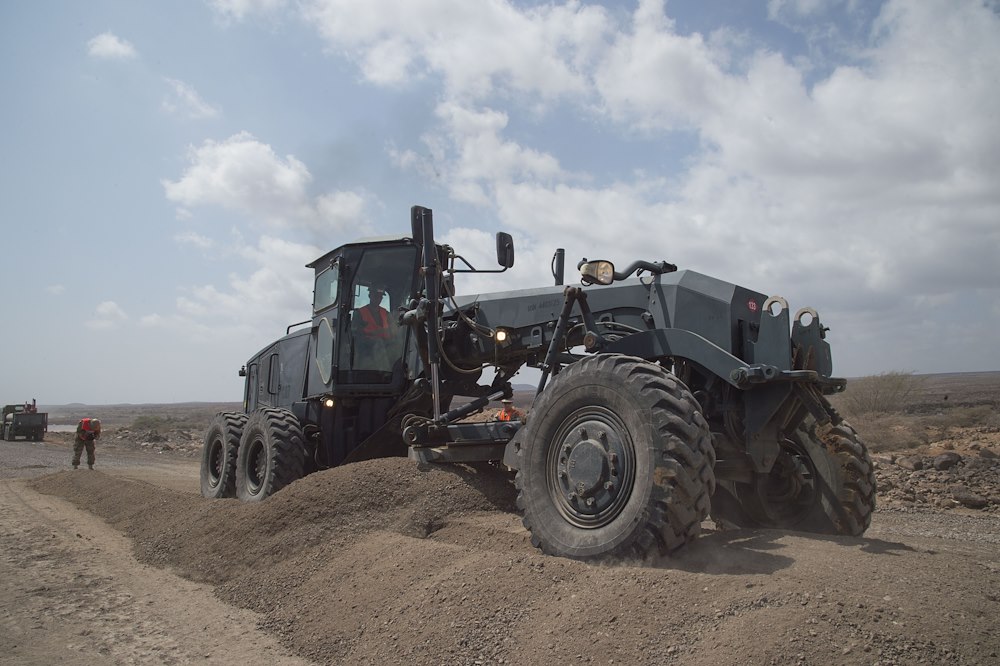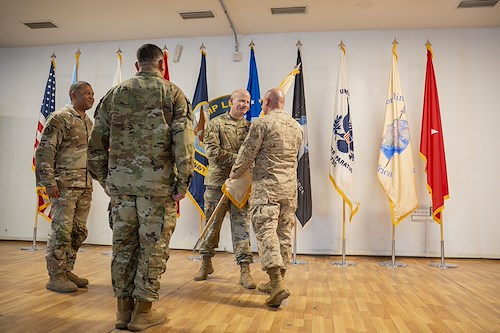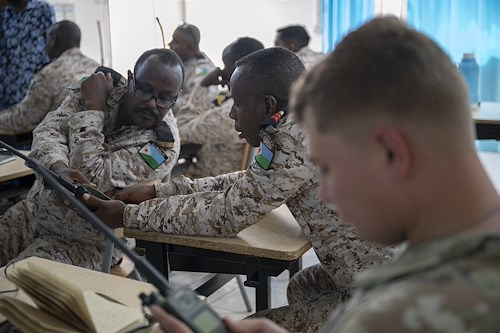Gallery contains 7 images
×
Photo 1 of 7
Combined Joint Task Force - Horn of Africa Image
U.S. Sailors from the Naval Mobile Construction Battalion 22 use a grater to spread a mixture of sand and gravel in the first step of creating a makeshift road May 2, 2016, at Chebelley, Djibouti. The road creation process includes leveling the sand and gravel mixture, then applying water before compressing it with a vibratory roller. (U.S. Air Force photo by Staff Sgt. Eric Summers Jr.)
Photo by: U.S. Air Force Staff Sgt. Eric Summers Jr.
Photo 2 of 7
Combined Joint Task Force - Horn of Africa Image
U.S. Navy Petty Officer 3rd Class Collin Scheffer, Naval Mobile Construction Battalion 133, operates a grater to evenly spread gravel during a road construction project May 2, 2016, at Chebelley, Djibouti. The battalion created approximately 800 feet of road, eight hours a day for two months. (U.S. Air Force photo by Staff Sgt. Eric Summers Jr.)
Photo by: U.S. Air Force Staff Sgt. Eric Summers Jr.
Photo 3 of 7
Combined Joint Task Force - Horn of Africa Image
U.S. Navy Petty Officer 2nd Class Michael Clark, Naval Mobile Construction Battalion 22 construction mechanic, signals for a dump truck to continue releasing a trail of sand and gravel during road construction May 2, 2016, at Chebelley, Djibouti. The mixture of sand is added to gravel allowing for it to be compressed into a makeshift road. (U.S. Air Force photo by Staff Sgt. Eric Summers Jr.)
Photo by: U.S. Air Force Staff Sgt. Eric Summers Jr.
Photo 4 of 7
Combined Joint Task Force - Horn of Africa Image
U.S. Navy Petty Officer 2nd Class Michael Clark, Naval Mobile Construction Battalion 22 construction mechanic, directs traffic during road construction May 2, 2016, at Chebelley, Djibouti. The sailors maintained control of the flow of traffic to ensure the safety of military personnel and traveling civilians. (U.S. Air Force photo by Staff Sgt. Eric Summers Jr.)
Photo by: U.S. Air Force Staff Sgt. Eric Summers Jr.
Photo 5 of 7
Combined Joint Task Force - Horn of Africa Image
Water is applied to a mixture of sand and gravel to create a solid surface with traction for vehicles to safely travel May 2, 2016, at Chebelley, Djibouti. The sand gravel is mixed together and then moistened with water to create a surface that can be compacted to form a road. (U.S. Air Force photo by Staff Sgt. Eric Summers Jr.)
Photo by: U.S. Air Force Staff Sgt. Eric Summers Jr.
Photo 6 of 7
Combined Joint Task Force - Horn of Africa Image
U.S. Navy Sailors from the Naval Mobile Construction Battalion 22 spray sand and gravel with water and compress it with a roller during a road construction project May 2, 2016, at Chebelley, Djibouti. The one-mile construction project took approximately two months to complete. (U.S. Air Force photo by Staff Sgt. Eric Summers Jr.)
Photo by: U.S. Air Force Staff Sgt. Eric Summers Jr.
Photo 7 of 7
Combined Joint Task Force - Horn of Africa Image
U.S. Navy Petty Officer 1st Class Chris Harris, Naval Mobile Construction Battalion 22 equipment operator, steers a vibratory roller to compress a mixture of wet sand and gravel to form a makeshift road May 2, 2016, at Chebelley, Djibouti. The construction battalion created the road to provide a safer route for military and civilians to travel. (U.S. Air Force photo by Staff Sgt. Eric Summers Jr.)
Photo by: U.S. Air Force Staff Sgt. Eric Summers Jr.
U.S. Navy Sailors from the Naval Mobile Construction Battalion 22, also known as Seabees, completed a road construction project May 2, 2016, at Chebelley, Djibouti.
The two-month construction placed a mile-long road of gravel to provide a safer route for more than 300 military members and Djiboutian civilians who use the road each day.
“Chebelley road was in pretty bad shape when we got here,” said Petty Officer 1st Class Toledo Emanuel, Naval Mobile Construction Battalion 22 equipment operator and project supervisor. “We are just making it safe for the people who drive here. It’s a lot of movement on this road so we are fixing the grade of it.”
The stretch of road contained numerous potholes, large rocks and other obstacles that drivers had to maneuver around to travel the road.
Each day the battalion placed approximately 32 cubic meters of a gravel and sand mix along an 800-foot stretch and compressed it to three-quarters of an inch thick.
“Once we receive the gravel we spread it with the grater, [evening out the road],” Emanuel said. “Then we use the water truck to water and compact it with a roller. This process usually takes about two hours.”
Petty Officer 1st Class Chris Harris, Naval Mobile Construction Battalion equipment operator, said the process is repeated multiple times down the stretch of road throughout the eight to ten-hour workday creating a noisy, traffic congested and hot environment for the team.
“I’d say roughly a hundred plus vehicles come through here each day,” Harris said. “Also, it’s hot, dusty and loud.”
Emmanuel said with so many factors, safety is a big concern so they set-up cones and traffic signals, as well as provided plenty of water to combat the Djiboutian heat.
The project ended near the Chebelley gate, concluding the battalion’s efforts of improving the road conditions for those who frequently travel.
“This road here should last, with regular maintenance, at least a year,” said Harris “The road is more travelable and is much more comfortable conditions to drive on. “


























